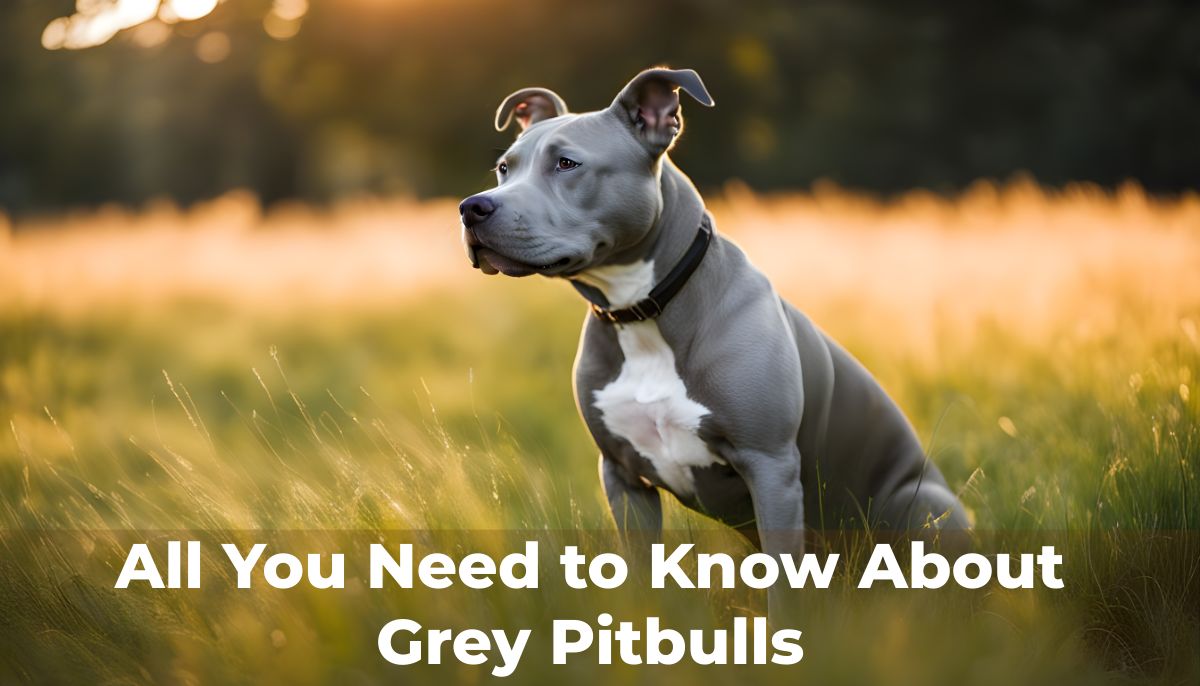Ever come across a grey Pitbull? These beautiful dogs are not just pets; they become loyal companions and perfect members of any family.
This article will be on the Grey Bully Breed, discussing their distinct features, background and reasons why they make great companions.
I want to use my knowledge and love for these incredible animals. I am here to share my knowledge and skills in pet care and dog breeds.
| Characteristic | Description |
|---|---|
| Coat Color | Grey |
| Temperament | Loyal, Affectionate, Intelligent |
| Size | Medium-sized (30-65 pounds, 17-21 inches at the shoulder) |
| Lifespan | 12-16 years (with proper care) |
| Popularity | Popular variation within the broader Pit Bull Terrier group |
| Suitable For | Families, Active Individuals, Owners with Experience |
| Adoption Availability | Often found in animal shelters and rescue organizations |
| Exercise Needs | Requires regular exercise and mental stimulation |
What is a Grey Pitbull?
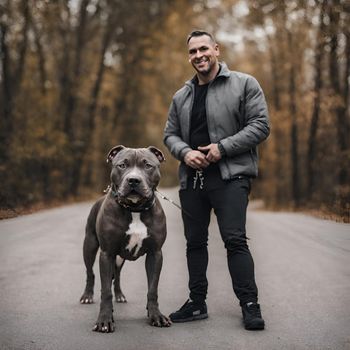
A Grey Pitbull is a dog known for its short, shiny grey coat and strong body.
These dogs have a unique, steel-grey coat that can appear bluish or silverish in different lighting conditions.
The distinct color is the result of a recessive genetic trait. Grey pitbull muscles are especially pronounced in their shoulders, chest, and hindquarters.
hey are known for their muscular build. They have a broad chest, powerful legs, and a well-developed neck.
Despite their sometimes intimidating look, they are usually friendly, loyal, and affectionate pets.
What is a Grey Pitbull called?
Owing to the fact that it has a unique coat color, a Grey Pit is often called many names.
Grey Pit: These animals are renowned for their grey coat.
Blue Pitties: With bluish or silverish fur.
Silver Pit: Named after their silver-like appearance.
Steel Grey Pits: Their coat is recognized as steel-grey.
Gray Pit: Just like the “Grey Pitbull”.
Gray Blue Pit: Their fur contains grey and blue shades together.
Pure & Mix Grey Pitbull:
Grey Pitbulls can be purebred or mixed. It means they can be either full-blooded with a lineage of Grey Pits in their ancestry or a combination of Pits and other dog breeds.
Pure Grey:
These dogs have a family tree that shows they come from a long line of Grey Pit bulls. It means they often have specific traits that Grey bullies are known for.
Mixed Grey:
These dogs have some Grey Pit bulls in them, but they’re not only Grey bullies. They might have a mix of other breeds in their background. It makes them unique and can lead to different traits.
What You Need to Know:
- Pure Grey Pits have easier-to-predict traits because we know much about their family history.
- Mixed Grey Pitties can have a mix of different traits and can also be fantastic pets.
When choosing between mixed and purebred Grey terriers, think about what you like and the dog’s specific personality. Your choice should match what you’re looking for in a furry friend.
Grey Pitbull History:
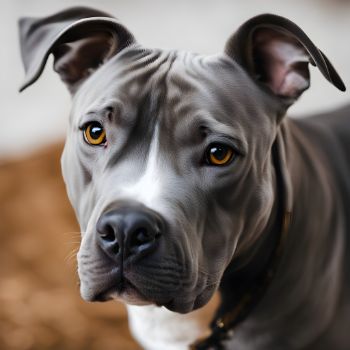
The history of grey pit bull dog is remarkable. The dogs have a background from the early 19th century when they were first bred for bull-baiting and farm purposes.
Grey Pits are loyal dogs that descended from a bulldog and terrier mix, their ancestors.
During the 20th century, Grey Pits were popular in the United States. They were trustworthy and benevolent house pets famous for their loyalty and guardian instincts.
Nevertheless, it is essential to mention that they were unfairly considered aggressive because of myths and misuse over time. Such challenges have resulted in breed-specific legislation in some regions.
The historical journey of Grey Pitbulls illustrates their strength of character and highlights their contribution to American culture. It shows a need for responsible ownership and proper treatment of these dogs today.
Here are some notable grey pitbulls in history:
- Buster: the therapy dog of 9/11.
- Sarge: It is said that he saved his owner’s life in Iraq.
- Ruby: an icon of hope and survival, once found her way out of a dogfight.
Grey Pitbull: How Did the Breed Get Popular?
Several reasons explain why the Grey Pitbull became popular. At first, they were bred for farming, but later they became good at handling cattle and guarding properties.
By doing this, they were able to earn a reputation as loyal and reliable companions. Families loved their affectionate nature and protective instincts.
Did You Know?
Grey Pitbulls are often featured in popular culture, such as the movies “The Sandlot” and “Red Dog”.
These dogs were commonly used in advertisements and signified American values in the early 20th century. They were adopted as the national mascots and symbolized values like bravery, loyalty and persistence.
They became famous through movies, TV shows, and war posters during World War I, where they were often depicted as lovely family dogs, enhancing their reputation.
The Grey Pits were loved but also encountered hurdles. Breed-specific legislation in areas affected their popularity resulting from misconception of their temperament and use in illegal activities.
Recognition of Grey Pitbull:
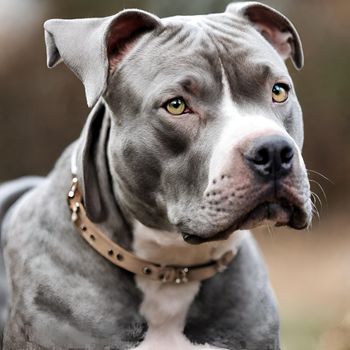
Some breed registries and kennel clubs recognize the Grey Pit bull. Such organizations are essential in recognizing and standardizing dog breeds.
United Kennel Club (UKC):
In the American Pit Bull Terrier category of the UKC, the Grey Pit bull is formally recognized as a variation of the American Pit Bull Terrier, since it is grey.
American Kennel Club (AKC):
The grey pit bull is not recognized as a separate breed by the AKC. On the other hand, they know the AmStaff and the American Pit Bull Terrier.
American Dog Breeders Association (ADBA):
Another organization that acknowledges the Grey Pit bull is the ADBA within the APBT group.
Other Registries:
It may or may not be recognized by several other breed registries, with recognition varying across different organizations.
How do they get their Grey coat?
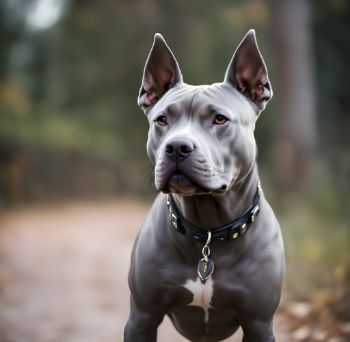
American pitbulls get their gray coat from a recessive gene that dilutes black pigment.
It’s a specific color variation inherited from their dad and mom.
This color variation occurs when the mother and father bring the gene for the Grey coat.
The color gene for the Grey coat is often called the “Dilution Gene.” When a Pitbull inherits copies of this gene (one from each figure), it dilutes the usual black or brown coat shade, resulting in the Grey coloration.
Grey pit bulls may have several shades of grey, from silver to charcoal. The grey shade depends on how much black pigment is diluted.
Are Grey Pitbulls Rare?
Yes, American Pitbulls with a Grey coat are surprisingly less commonplace than their different pitbull colors, consisting of black, brown, and brindle.
Their rarity is due to the genetic factors producing this specific coloration.
The American Pitbulls’ grey coat results from a specific genetic combination. Both figure puppies must deliver the Dilution Gene to produce Grey offspring. Since not all Pitbulls carry this gene, Grey ones are less regularly visible.
The rarity of grey pit bulls has led to some breeders charging higher fees for them.
While they may be less commonplace, Grey Pitbulls are loved for their particular appearance and mild nature. Their rarity appeals to the ones drawn to their beautiful, specific gray coloring.
So, while Grey bullies won’t be as abundant, they are certainly special and valued by those who adore them.
Height and Weight:
The Grey Pit Bull is a medium-sized canine acknowledged for its robust and muscular construct. They typically stand around 18 to 21 inches tall on the shoulders (withers).
According to the United Kennel Club:
- Male grey Pitbulls typically weigh between 35 and 60 pounds and stand 18 to 21 inches tall on the shoulder.
- Female grey pit bulls are commonly smaller, weighing 30 and 50 pounds and standing 17 to 20 inches tall at the shoulder.
They have a large head, a well-defined jawline, and expressive eyes that carry their alert and pleasant nature.
Grey Pitties have a straight back and a well-balanced body, giving them a poised and confident posture. Their tail is usually short and tapers to a point.
Here are some other physical characteristics of grey Pits:
- Strong, muscular build
- Short, glossy coat
- Broad head
- Powerful jaws
- Strong teeth
- Medium-length tail
Personality and Temperament:
The Grey Terrier is known for its loving and constant nature. They are frequently considered pleasant and dependable puppies. Here are a few key factors about their character:
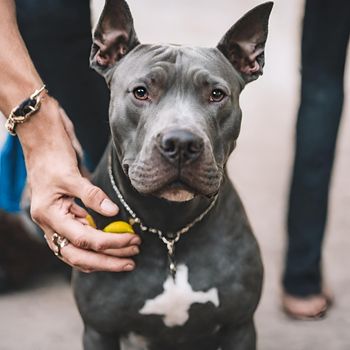
Affectionate: They are recognized for their affectionate nature. They have a tendency to form strong bonds with their human partners and are frequently keen to shower them with love and attention.
Protective: These puppies have a shielding intuition. They may be watchful and alert, making them exactly protect dogs. They are, in all likelihood, to look out for their family’s well-being.
Playful: Grey staffies are usually playful and full of energy. They experience interactive play and workouts, making them splendid companions for lively people or households.
Intelligent: They are recognized for their intelligence and can be quick learners. It makes them appropriate for diverse education activities and responsibilities.
Social: Grey Pit Bull Terriers enjoy social interactions with their families and other dogs. Proper socialization is essential to make sure they have effective interactions with others.
Health Conditions:
Like all breeds, Grey Pits can be prone to specific health issues. Potential owners must know these conditions and properly care for their pets. Here are some crucial factors:
Hip Dysplasia: It is a not unusual problem in Grey Pits. It’s a situation where the hip joint does not broaden effectively, leading to pain and decreased mobility.
Skin Allergies: These dogs may be more susceptible to skin allergies, which can cause itching and discomfort. Proper grooming and a balanced diet can help reduce the risk of allergies.
Heart Disease: Some Pitbulls can have increased coronary heart troubles, like congenital coronary heart disorder.
Cancer: These dogs can be at risk for certain types of cancer. Regular check-ups and a healthy lifestyle can help reduce the likelihood of cancer development.
Obesity: Grey Pitbulls can gain weight easily, leading to various health problems. Regular exercise and a well-balanced diet are essential for maintaining a healthy weight.
Degenerative myelopathy: It is a progressive neurological disease affecting the spinal cord. It can cause weakness, paralysis, and bladder and bowel control loss.
Food and Diet:
Feeding a big Grey Pitbull is an important aspect of their care. Their nutritional needs are pretty similar to other dogs, but due to their size and activity level, there are some key points:
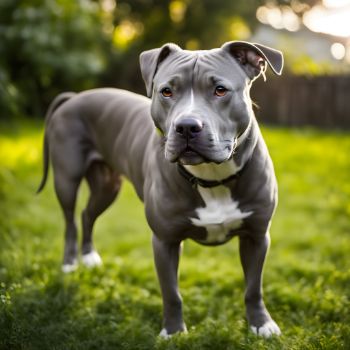
High-Quality Dog Food: Choose a dog food that lists meat as the primary ingredient. It provides the necessary protein for their active lifestyle.
Protein: These dogs especially the larger ones, require a good amount of protein. Look for dog food that contains around 20-30% protein.
Fat: Fat provides energy, so a moderate amount of healthy fats in their diet is essential. Look for around 10-15% fat content in their food.
Portion Control: Be mindful of portion sizes. Big Grey Pitbulls can gain weight quickly, so ensure they’re fed the right amount for their size and activity level.
Fresh Water: Always provide fresh water. Hydration is crucial for their health, especially if they’re active.
Avoid Harmful Foods: Some foods can harm dogs. Keep chocolate, grapes, raisins, and foods with artificial sweeteners away from them.
Exercise for Large Grey Pitbulls:
These strong and active dogs require much exercise to stay healthy and happy.
Daily Walks: Large Pitbulls benefit from daily walks, ideally at least 30-60 minutes of brisk walking to help burn off energy.
Playtime: Engage in play sessions like fetch, tug-of-war, or interactive toys to keep them mentally and physically stimulated.
Running and Jogging: Your large pit bull can be a great running or jogging partner if you’re active. They love to run alongside their owners.
Obedience Training: Incorporate training into exercise to keep their minds sharp. It’s a win-win for mental stimulation and exercise.
Off-Leash Play: If you can access a secure, fenced area, let your large Grey Pitbull enjoy off-leash play to stretch their legs.
Exercise for Tiny Grey Pitbulls:
They are just as energetic but have smaller bodies. Here’s what to keep in mind:
Shorter Walks: While little Grey Pitbulls need exercise, their walks can be shorter, around 15-30 minutes, to prevent overexertion.
Indoor Play: Engage in indoor play like fetch in a hallway or interactive toys to accommodate their smaller size.
Mental Stimulation: Little Pitbulls benefit from puzzle toys and games that challenge their minds.
Socialization: Encourage socialization with other dogs in a safe, supervised environment. It can be a form of exercise too.
Gentle Training: Obedience training is important for these dogs, too. Use positive reinforcement methods to keep them engaged.
Grey Pitbull Training:
When it comes to training the Grey Pitties:
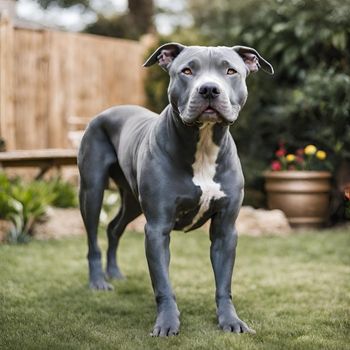
Start Early: Begin training when they are young, as teaching good habits is easier.
Positive Reinforcement: Use rewards like treats and praise to encourage good behavior. It helps them learn faster.
Consistency: Be consistent with commands and rules. It helps them understand what’s expected.
Patience: Training takes time, so be patient. Don’t lose heart if they don’t grasp it immediately.
No Harsh Punishments: Avoid harsh punishments. It’s better to redirect their behavior and reward what you want.
Safety: Ensure their safety and the safety of others during training. Utilize a leash or a secure enclosure.
Grooming and Cleaning:
Keeping your Grey Staffie easy and properly groomed is crucial for their health and happiness. Here are a few easy tips:
Bathing: Give your canine a bath each 2-3 months or when they get grimy. Use dog shampoo to keep their coat smooth and vivid.
Brushing: About once every week, regular brushing allows put off free hair and maintains their coat. It’s an extraordinary manner to bond with your pup.
Ears: Check their ears for dust or wax buildup. Use a damp material to clean them gently, but don’t insert anything into their ear canal.
Nails: Trim their nails if you hear them clicking on the ground. A vet or groomer can assist if you are uncomfortable doing it yourself.
Teeth: Brush their tooth frequently to avoid dental problems. Use a dog-specific toothbrush and toothpaste.
Eyes: Keep an eye on their eyes for any discharge. Use a moist, smooth cloth to wipe away any gunk.
Wrinkles: If your dog has pores and skin wrinkles, like some Pitbulls, clean and dry these areas properly to avoid skin troubles.
4 Unique Facts about Grey Pits:
These unique facts make Grey Staffies a special breed.
Nose Print ID:
Like human fingerprints, each Grey Staffie’s nose print is unique. It’s their stamp of identity.
Pocket-Sized Bed Hog:
Despite their compact size, Grey Staffies can take up an entire bed when sleeping. It’s almost like they have a “bed-hog” superpower!
Gentle Giants:
Despite their robust appearance, Grey Staffies are known for their gentle and loving nature. They’re often called “gentle giants” because of their affectionate and friendly demeanor.
Clever Problem Solvers:
Grey Staffies are intelligent and clever problem solvers. They love puzzles and interactive toys that challenge their minds.
Are Grey Pitbulls good family dogs?
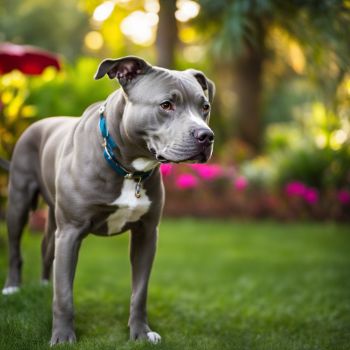
These dogs can be awesome family dogs. These loyal and affectionate puppies often shape robust bonds with their families.
They are recognized for their protective instincts, making them terrific at retaining an eye on the home and its members.
One crucial issue to take into account is early socialization and education. They can be playful and active; while well-skilled, they can be gentle with kids.
Teaching the canine and the kids to engage and play competently together is crucial. Always supervise interactions with young youngsters to ensure everyone remains safe and satisfied.
Relation with Children:
If raised in a loving and nicely structured environment, Grey Pitbulls can be incredible playmates and protectors for youngsters. Their affectionate nature often shines via their relationship with youngsters. They tend to be gentle, making them a good choice for households with kids.
These dogs love to play, and their energy can match that of youngsters, making them outstanding partners for sports like fetch or playing in the backyard. Grey Pitbulls are strong; even the most nicely behaved dog may react if they experience threatened or harm.
Does Grey Pitbull shed?
Greyish-blue pitbulls do shed, but the amount can vary from one dog to another. Shedding is a natural process in which old or damaged hair falls out to make way for new growth.
All dogs shed to some extent, but the frequency and amount of shedding can depend on factors like genetics, health, and the dog’s environment.
These dogs shed the most in spring and fall when shedding their winter and summer coats.
Its short, sleek coat can make the shedding less noticeable compared to dogs with longer fur. They are often considered low to moderate shedders.
They typically shed year-round, with some variation in shedding intensity during seasonal changes, like in spring and fall.
Is Grey Pitbull hypoallergenic?
Grey Pits are not considered hypoallergenic dogs. Hypoallergenic dogs are breeds that produce fewer allergens, which can be easier for people with allergies. Like most other Pitbulls, Grey Pitbulls have short, sleek coats that don’t trap allergens as much as longer-haired breeds.
However, it’s essential to understand that the proteins found in a dog’s skin cells, urine, and saliva usually trigger allergies, not just the hair.
Even dogs with short coats can still produce these allergens. So, while Grey Pitbulls may shed less compared to long-haired breeds, they are not hypoallergenic.
If you or someone in your family has allergies but are still interested in having a dog, it’s a good idea to spend time around Grey Pits or other breeds to see how your allergies may react.
Grey Pitbull Puppy:
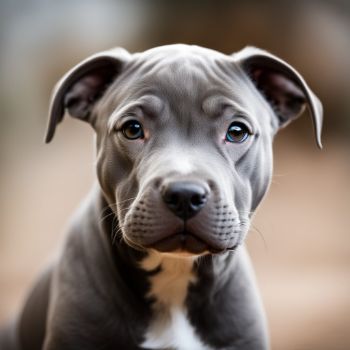
A Grey Pit pup is a young dog of the Grey Terrier breed, known for its short grey coat and often striking eye colors, like blue or green.
You’re in for a treat when you bring a Grey Bully puppy home. These little furballs are known for their boundless energy and affection. They’re like a bundle of joy that can light up your life.
Grey bully puppies typically have short, sleek coats. These coats come in various shades of grey, from a light silvery grey to a deeper charcoal grey.
The coat is easy to care for and doesn’t require as much grooming as longer-haired breeds.
While brown is a common eye color, you might also come across Grey Pit puppies with striking blue or green eyes. The contrast of these bright eyes against their grey coats can be mesmerizing.
Grey Pitbull puppies are known for their friendly and affectionate nature. They’re also loyal and protective, making them excellent family pets. Like all puppies, they need proper healthcare and vaccinations.
Do Grey Pitbull Pups Change Color as They Mature?
Grey-blue pitbull puppies may experience some changes in their coat color as they mature.
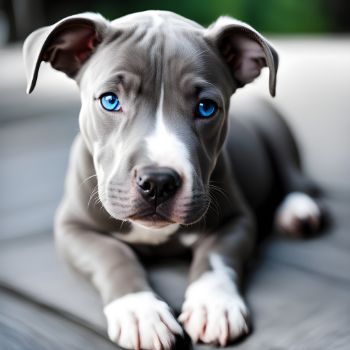
While the base color of their coat, which is grey, typically remains consistent, some Grey Pitbull pups might develop slightly different shades of grey as they grow.
It could be due to various factors, including genetics and exposure to sunlight.
Sometimes, a grey pit puppy may have a lighter-colored coat that darkens as they grow.
It is because the puppy’s coat is still developing and the full color has not yet emerged. As the puppy’s coat matures, the darker shades of grey will become more prominent.
One of the most noticeable changes in some puppies is related to their eye color. Some are born with striking blue or green eyes, but their eye color may shift to a more typical brown or hazel as they age. It is a common occurrence in many dog breeds.
It’s important to note that not all Grey Pit puppies go through significant color changes. Many retain their original coat and eye colors throughout their lives.
Pros:
Loyal and Loving: Grey Pitbulls are loyal and love their owners deeply.
Family-Friendly: They’re great for families because they’re affectionate and loving.
Protective: Grey Pits can protect their families and add security.
Low Grooming: Their short coats need minimal grooming.
Cons:
Misunderstood: People often need to understand them, leading to breed-specific laws in some places.
Training Needed: They’re intelligent but can be stubborn, so training is crucial.
Banned in Some Areas: In certain places, they’re banned due to their reputation for aggression, making it hard for owners to find housing and services.
Grey Pit Blue Eyes:
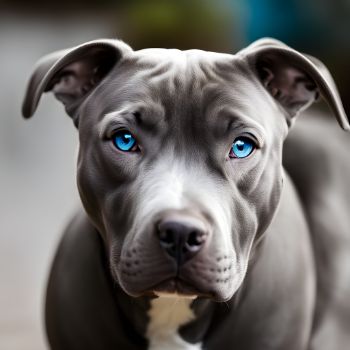
Grey pitbulls with blue eyes are uncommon, but they exist. The blue eye color in Grey Staffies is often due to a lack of pigmentation in the iris.
This lack of pigment can result in shades of blue, from light baby blue to a deeper, more intense blue.
It adds to the unique charm of these dogs and sets them apart from other Pitbulls.
Blue eyes are more common in grey American bully puppies than adult dogs.
It is because the melanin in the iris continues to develop as the puppy grows.
As a result, some puppies with blue eyes may develop brown eyes as they mature.
Grey-Eyed Pitbull:
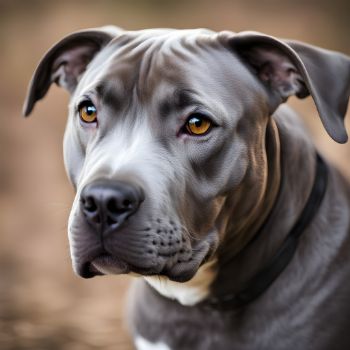
A grey-blue Pitbull is a dog with a unique shade of greyish-blue eyes.
Grey eyes are the most common eye color for grey staffies.
They can range from light grey to dark grey, and some may even have a hint of blue.
Their grey eyes range from a light, silvery grey to a deeper, more intense shade.
The contrast between their grey eyes.
Grey eyes in pitbulls are caused by a recessive dilution gene that reduces the amount of melanin in the eyes.
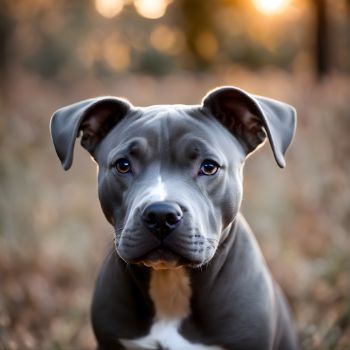
Grey Blue Nose Pit:
A grey blue-nose pitbull has a grey coat and a blue nose. They have a unique greyish-blue nose leather.
What makes these Pitbulls stand out is their nose color.
Instead of the typical black nose that most Pitbulls have, Grey Blue Nose Pitbulls have a nose that looks more like a cool shade of grey or blueish-gray.
When Grey Blue Nose Pitbulls are tiny puppies, they often have those adorable blue noses. And guess what?
Many keep this unique blue nose color as they grow into big, full-grown grey pit bulls.
It’s like having a special badge they carry throughout their lives.
Grey Nose Pitbull:
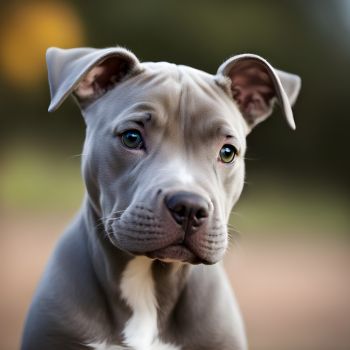
The grey nose Pitbull is a variety of the Pitbull breed with a big, grey-colored nose.
The grey nose color in these Pitbulls is typically associated with genetics.
It’s like inheriting a unique feature from their parents.
Whether they’re little puppies or full-grown adults, grey Nose Pits continue to have unique grey noses.
Did you know?
Grey Staffies have been known to breakdance when they hear their favorite tunes?
Just kidding!
While they might not breakdance, these dogs have some impressive moves on the dance floor when it comes to playing and grooving with their owners.
Grey Red Nose Pitbull:
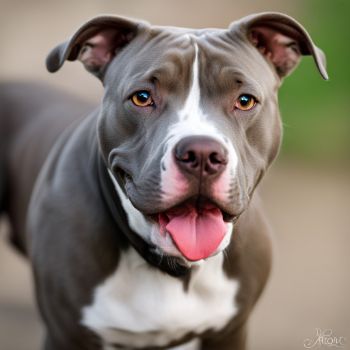
A grey red-nose pitbull has a grey coat and a red nose.
This unique coloration is caused by a combination of two recessive genes:
- The dilution gene reduces the amount of melanin in the dog’s fur and skin.
- The red nose gene produces a reddish pigment in the nose.
Grey red nose pit bulls can be found in various shades of grey, from silver to charcoal.
Their noses can range from light pink to dark red.
All Grey Pitbull:
Fulll-grey Pitbulls have a uniformly gray coat. This gray coat can range from light to dark shades, resembling the color of steel or a cloudy sky. All-grey Pitbulls are easily recognized due to their uniform gray coat.
Blue Grey Pitbull:
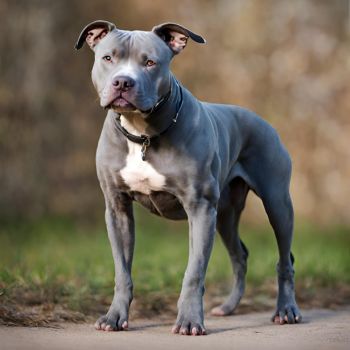
So, some bullies have a unique grayish-blue color.
People like to call them Blue Grey Pitbulls.
This unique color variation happens because of certain genes in these dogs.
When two blue-grey pitbulls have puppies, some will also have this cool gray-blue color.
It’s a family trait that can pop up in the new generation.
Light Grey Pitbull:
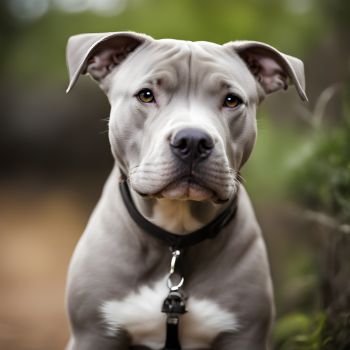
It has a silver or light grey coat color.
They can have shades of light grey, from very light silver to medium grey.
Light grey pit bulls are not a specific breed; any pits with the recessive gene responsible for this light grey coloration are considered light grey staffies.
These pits can be found in different Bully breeds, including APBT, American Staffordshire Terriers, and Staffordshire Bull Terriers.
These dogs maintain their special coat color throughout their lives.
Dark Grey Pitbull:
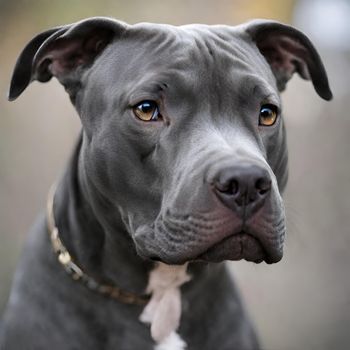
Dark grey pit bulls are dogs with dark grey coats. This color variation is unique and often looks very striking.
Dark grey pits with blue eyes also exist, which can make them even more special.
A recessive gene causes this coloration, and it is relatively rare.
Now, when two pit bulls with the right genes come together and have puppies, those puppies can inherit the dark grey coat color.
It is how we get dark grey American bully puppies.
Grey Brindle Pitbull:
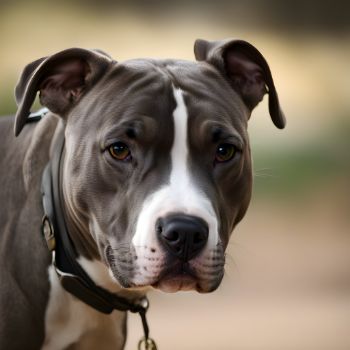
Grey brindle pit bulls have a coat that is made up of two colors: grey and brown.
The brown hairs distributed in stripes or swirls on the grey base coat create the brindle pattern.
Brindle Grey pit bulls can have a variety of shades of grey, from silver to charcoal, and their brown stripes can range from light tan to dark chocolate.
A dominant gene causes the brindle pattern. It means that only one parent needs to have the brindle gene for the puppy to inherit it.
- Brindle grey pit bulls are relatively rare. The brindle pattern is more common in red and black pits but can also be found in grey ones.
- The brindle pattern in grey brindle pit bulls can be very variable. Some dogs may have faint brindle stripes, while others may have bold and contrasting colors.
- The brindle pattern can also change over time. As a grey brindle ages, its stripes may become more pronounced or fade.
Grey Tri-color Pitbull:
A Grey Tr-color Pitbull is a type of dog known for its coat color that combines three primary colors – grey, black, and white.
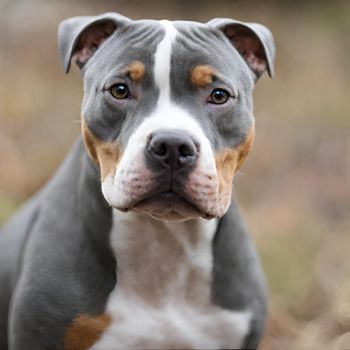
They can have a variety of eye colors, including blue, brown, and grey.
These dogs have a grey base coat, which serves as the canvas for their unique tri-color pattern.
Black markings or patches are distributed over their grey coat.
The third element in the tri-color scheme is white, which appears as patches or markings alongside the grey and black.
The arrangement and size of these three colors can vary from one APBT to another.
Grey Fawn Pitbull:
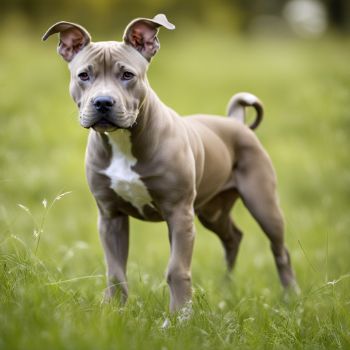
A Fawn Grey Pitbull has a soft, sandy, or light brown coat.
The “fawn” aspect describes this tan-like hue or beige color that covers their fur.
It’s a bit different from the solid grey Pitbulls you might be used to seeing.
- The “grey” part is the predominant color, creating a calm and sleek appearance.
- The “fawn” element adds a warmer touch, giving the coat a slightly brownish or tan tone.
The APBT coat is created through the interplay of genes at the A and E loci, with the “a” allele responsible for the fawn color and the “Em” allele allowing the grey and black to join in.
Silver Grey Pitbull:
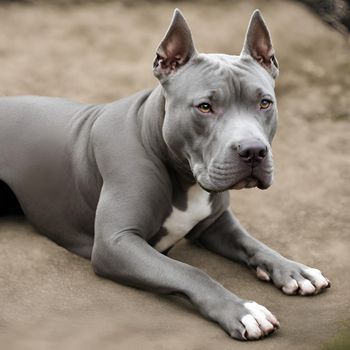
Grey Silver Pitbull is used for dogs with a silver or grey coat color.
A recessive gene causes the grey color variation called the dilute gene.
This gene dilutes the black pigment in the coat.
It results in shades of grey from light silver to dark charcoal.
Let me give you an example of how the dilute gene is inherited:
- Parents:
- Father: Black coat (no copies of the dilute gene)
- Mother: Grey coat (two copies of the dilute gene)
- Offspring:
- 50% chance of having a grey coat (one copy of the dilute gene from each parent)
- 50% chance of having a black coat (no copies of the dilute gene from either parent)
Charcoal Grey Pitbull:
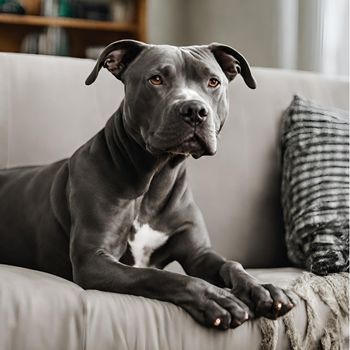
Grey Pitbulls come in various shades of grey, and one of those shades is called charcoal grey.
You can think of charcoal grey as a dark and rich color, like the color of charcoal when it’s burned.
It’s a bit darker than regular grey.
This color variation in grey canines is not as common as some other shades of grey, like light grey or silver grey, but it’s still very lovely.
Charcoal grey pit bulls often have shiny, sleek coats that make them look elegant.
Tan and Grey Pitbull:
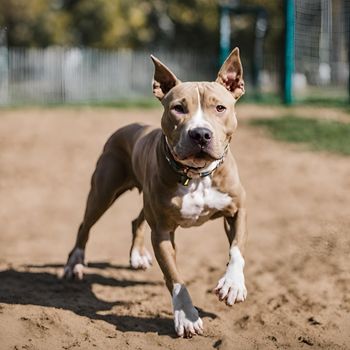
Some pit bulls have a mix of grey and tan colors in their fur. It is also known as a Buff grey pitbull.
Imagine the color of the grey sky, and now mix in a warm tan color like the sand at the beach.
This combination creates a unique and attractive look in these Staffies.
These dogs often have a coat that mixes these two colors.
Sometimes grey is the dominant color with tan markings, and in other Pits, the tan stands out with a grey backdrop.
It’s like a beautiful painting on their fur.
Grey and White Pitbull:
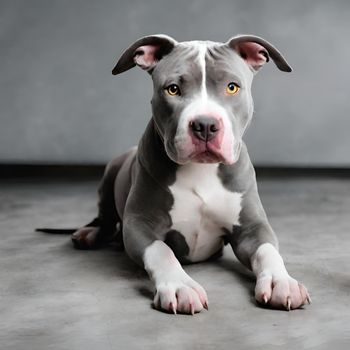
Grey and white terriers are a special dog breed. Imagine a mostly grey dog with some areas of white mixed in. It is also called Merle Grey Pitbull.
White and Grey pitbull puppies have that distinctive color from a young age.
The white and grey patterns become more obvious as they grow.
The grey and white pitbull puppy with blue eyes is captivating, and people often admire them. It’s like they have a touch of magic in their eyes.
You’ll notice that they have a mix of grey and white fur. Some may have more grey than white, while others might be mostly white with grey patches.
Black and Grey Pitbull:
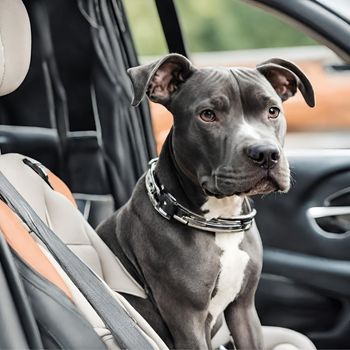
So, imagine you have a grey Terrier. Now, picture that grey dog with some black in its coat.
That’s what we call a black and grey canine. These dogs have a very cool and unique color scheme.
A grey and black pitbull is like a regular Staffie, but with black patches or stripes on its grey fur.
It’s almost like they’re wearing a black coat over their grey one.
When black and grey American bully puppies are born, they might have tiny black spots or hints of black on their grey hair.
As they grow, these black areas become more defined.
Brown and Grey Pitbull:
Grey Pit bulls come in different colors, and one of those colors is brown. It’s like how people can have different hair colors.
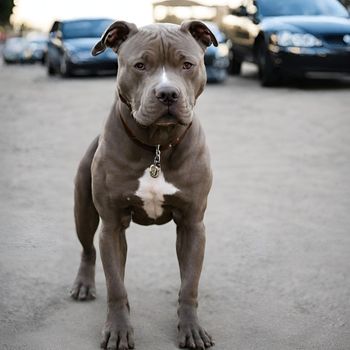
Imagine if you have a friend with brown hair and another with grey hair. Grey Pit Bull Terriers can be like that but with their fur.
The brown color in pretty Grey Pitbulls is a variation. It’s like having different shades of the same color.
Just like you can have light and dark brown, They can have different shades of brown in their fur. Some might have a light brown color, and others might have a darker brown shade.
Grey is the main color of Grey Pits, but sometimes they can have patches or spots of brown. It’s like having a grey sweater with brown patches on it.
These brown patches can be on their body, face, or ears, adding a special touch to their overall look.
Light-Brown Grey Pitbull:
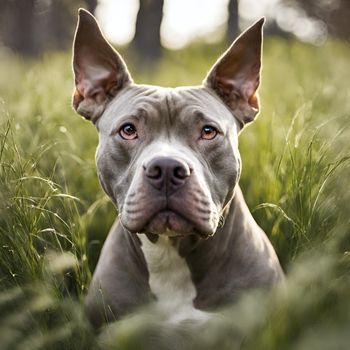
So, as I have told you about brown and grey pit but the shades of brown also vary in them.
This variation in brown has a lighter color than normal brown and people are often looking for it so I’ll give you a quick guide on it.
It is a unique color you might not see as often as the more common grey or blue colors in pit bulls.
It’s like having a grey coat with a touch of warm, light brown mixed in.
The light-brown patches or highlights on their grey fur can vary from dog to dog.
Some may have just a little bit of light brown, while others might have more.
Lavender Grey Pitbull:
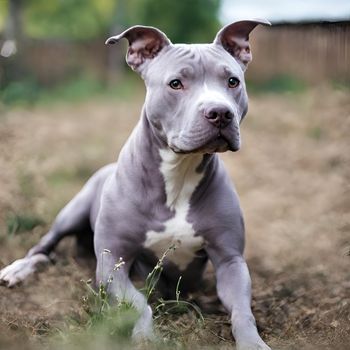
In different shades of staffies, there is one shade called lavender grey.
It’s like adding a touch of pale purple to their grey coat.
It’s a light and soft kind of grey. It might remind you of the color of lavender flowers, a pale purplish-blue. It is not a purebred breed.
These grey lavender pit bulls have a unique and beautiful coat color.
It’s uncommon, so if you ever see one, you’ll notice they look lovely and different compared to other grey bullies.
Is the Grey Pitbull right for me?
It’s important to think about some things before deciding if it’s a good fit for you.
- These dogs can be strong and need space to move around. If you have a big yard, that’s great. But if you live in a small apartment, it might not be the best idea.
- Grey Pit bulls are active and playful. They can be a good buddy if you like playing and going for walks. But it might not be the right match if you’re not very active.
- These dogs are smart, but they need training and socializing. Are you ready to spend time teaching them good behavior and introducing them to other people and pets?
- Dogs need love and care. Are you ready to give them the attention they need, like feeding, grooming, and regular check-ups at the vet?
- Think about your family and lifestyle. Are you ready for the responsibility of having a pet? If you have young kids, make sure the dog is good with children.
Grey Pitbull Price:
The cost of Grey Pitties can vary. It’s like when you shop for different things and find that some are more expensive. When it comes to Grey Pitties, you might see them priced between $1,500 and $3,000.
Grey Terriers are generally more expensive than other colors, such as black or brown. It is because grey pits are considered to be more rare and more desirable.
Some Grey dogs come from special families with a strong history of good traits. Dogs from these lines can be more expensive because they’re seen as top-quality.
Puppies with all their shots and health check-ups might be pricier because you won’t have to spend as much on vet bills.
Grey Pitbull Puppies for Sale:
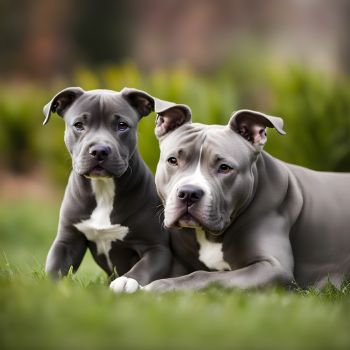
If you’re interested to get a cute Grey Pitbull puppy, it’s important to do some research and find a responsible breeder or a rescue organization.
Once you have found a reputable breeder, you can start choosing a puppy.
Always get the information about the personality and temperament of the puppy from the breeder.
You should also ask about the puppy’s health history and any vaccinations or deworming that has been done.
Grey Pitbull for Adoption:
Adopting a grey pit bull puppy from a shelter or rescue organization is another great option. These puppies often come from loving homes but have ended up in a shelter for whatever reason. Shelter and rescue organization staff can help you find a puppy that matches your lifestyle and needs.
Grey Pitbulls are typically low-energy dogs and do not require a lot of exercise. They are content to cuddle up on the couch with their families or play fetch in the backyard.”
– Grey Pitbull Rescue
No matter where you choose to purchase a grey pit pup, do your research and ensure that you are getting a healthy and well-bred dog.
Where To Get a Grey Pitbull Puppy?
When trying out for a grey pit pup, it isn’t just physical. Let us look at their well-being, bringing up, and habitat.
Word of Mouth:
Sometimes, friends, family, or even neighbors might know of someone who has Grey bully puppies. They could connect you with a pretty Grey Pit looking for a new home.
Online Searches:
The Internet is another helpful tool. Search online or in local media for grey pitbull puppies on sale.
Breeders:
For a purebred grey terrier, reach out to an accountable breeder. Most of them possess male and female pups.
Rescue Organizations:
There are many rescue groups that try to place dogs in good homes, including Grey Terriers.
Black Dog Syndrome Misconception:
“Black Dog Syndrome” is a term that refers to a situation where black dogs, like a Grey Pitbull with a black coat, often have a harder time finding homes compared to dogs of other colors. They face a little challenge when it comes to adoption.
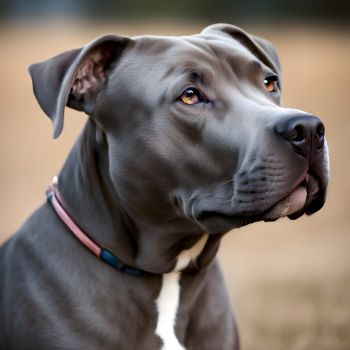
There are a few reasons for this:
1. Misconceptions:
Some people have misconceptions that black dogs, including black-coated Grey Pitbulls, might be aggressive or less friendly. But a dog’s behavior mostly depends on their upbringing and training, not their coat color.
2. Photography:
Black dogs can be harder to photograph, so their pictures might not stand out as much online or in adoption listings. Sometimes, it’s just about not getting the chance to shine in photos.
3. Superstitions:
In some cultures, black animals are associated with superstitions, which can affect people’s preferences.
Grey Pitbulls are particularly vulnerable to BDS because they are often seen as black and dangerous.
If you are considering adopting a dog, please consider a grey Terrier. These dogs are loving, loyal, and make excellent companions.
By adopting a grey Pit, you can help raise awareness of BDS and encourage more people to adopt black dogs.
Mixed Breeds similar to Grey Pitbull:
If you’re looking for a dog that’s like a Grey Pit but not a purebred, there are some mixed breeds that you might find interesting. These mixed breeds can share similar traits and qualities:
Labrabull:
This mix combines a Labrador Retriever and an AmStaff. They can be strong and friendly, like cute Grey Staffordshire.
Boxer Bulldog:
Mixing a Boxer with a Bulldog can result in a cute and playful pup with some similarities to Grey Bullies.
Greyhound Staffordshire Mix:
This breed combines the Greyhound and APBT, resulting in a sleek and athletic dog known for its speed and strength.
American Staffordshire Terrier Mix:
This mix often has some qualities of a Grey Terrier since they belong to the same family of dogs.
Bullmastiff Mix:
Mixing a Bullmastiff with an American Pit Bull Terrier can result in a strong and protective dog with similar traits.
Rottweiler Mix:
When you mix a Rottweiler with an APBT, you can get a loyal and protective dog, similar to Grey Terriers.
Grey Terrier Lab Mix:
A mix of a Grey Terrier and a Labrador Retriever, creating a friendly and energetic dog with a love for play and outdoor activities.
What Is The Difference Between Grey And Blue Pitbulls?
The difference between grey and blue pits is in their coat color. Grey bullies have a light to dark grey coat, while blue pit bulls have a bluish-grey coat.
Are Grey Pitbulls Aggressive?
Grey pit bulls are not inherently aggressive. Their behavior depends on their upbringing and training, just like any other dog.
Why Are Grey Pitbulls Called Blue?
Grey Pits are sometimes called “blue” because of their bluish-grey coat color. It’s just a nickname for this specific color variation.
Are all grey pitbulls blue noses?
Not all grey pit bulls are “blue nose.” “Blue nose” refers to a pitbull with a bluish nose and is separate from their coat color.
What kind of pitbull is Grey?
Grey pitbulls can belong to different breeds, such as the American Pit Bull Terrier or the American Staffordshire Terrier. The grey color can occur in various pitbull types.
Final Words:
Grey pit bulls are unique and lovely dogs with cool grey or bluish-grey coats. These colors are determined by their genes, just like how you inherit traits from your family.
Grey Pits are not naturally aggressive; their behavior depends on their upbringing and training. They come in different types, like the APBT or American Staffordshire Terrier.
If you’re thinking of getting a dark grey pitbull puppy, remember that their personality is shaped by love and care.

